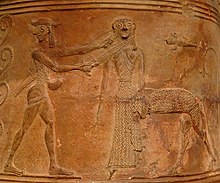Relief pithos
As Reliefpithoi ostentatious be Pithoi referred ranging from about 750 to v 650th Chr. To the Cyclades , on Crete and Rhodes were produced. Later production of these vessels took place in Sparta in the fourth century . Because they have handles, they were often referred to as relief amphorae in the past .

The relief pithoi are usually 1.50 to 2 m high. They have a long neck and end in a pointed base. In the lower third there are mostly recesses into which wooden sticks were once stuck so that the pithoi could stand firmly on the ground.
These pithoi got their name from the flat reliefs that were made on them. These are either freely shaped or stamped with the help of dies . There are geometric decorations, but also figurative scenes. The decoration was rarely painted, only in Crete was color used. Only the front or front side was decorated. The clay of the vessels is usually rather coarse, the reliefs are made of finer clay.
The main motif of the decoration was always on the neck. There are mainly scenes from Greek mythology . A large specimen found on Mykonos shows scenes from the conquest of Troy , with the Trojan horse as the main image on its neck. It is the oldest depiction of the Trojan War to date . Another popular motif is the mistress and the Lord of the animals, or the representation of a brainchild , and it is debatable whether this the birth of Athena is meant. A major production center was apparently the island of Tinos .
literature
- Werner Ekschmitt : Art and Culture of the Cyclades. Volume 2: Geometric and Archaic Time (= cultural history of the ancient world . Vol. 28, 2). von Zabern, Mainz 1986, ISBN 3-8053-0900-7 , pp. 146-159.
